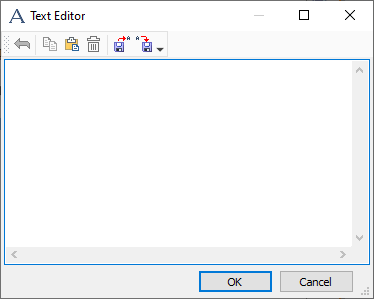String Text |
  
|
String text can be created using the following automenu option within the Text command:
|
<D> |
Create string text |
String text may contain any number of lines and any number of characters within the line. When inputting the text content, press <Enter> or <Shift>+<Enter> for adding a line.
String text always lays within a single bounding rectangle. Size of a rectangle is not fixed. It expands or shrinks depending on the size of text content. When adding the content to a current line, the rectangle expands horizontally, when adding new lines - vertically. The direction of expansion or shrinkage depends on the selected position of text in relation to its anchor point.
Text content is inputted in the Contents tab of the text parameters dialog or in the crippled version of the text editor. Elements insertion capabilities are limited compared to other types of text.
The font parameters dialog and paragraph parameters dialog are not available for string text, therefore such parameters can not be customized individually for different parts of the same text. Font parameters and line spacing can be customized for the whole text at once using the Font tab of the text parameters dialog.
Unlike other types of text, string text can be split line by line into several texts using the editing command.
Upon selecting a string text option in the automenu of the Text command, you need to define an anchor point in one of the ways described in the Position and Orientation of Text section. Upon defining an anchor point, the creation of text gets finished and the system switches to editing the created text. However, the usual mode of editing the text content in the view window is not available for string text.
By default, upon defining an anchor point, the Contents tab of the text parameters dialog gets opened. You can type in the text content there. Unlike other types of text, when inputting the content of a string text, there are no automenu options and no contextual menu of text content available. If you need to insert some elements into text, use the regular contextual menu. The text input box in the Contents tab is essentially the same as any other input box, which you may encounter in other T-FLEX CAD windows. Therefore it has the standard set of commands available in the contextual menu. More information can be found in the Contextual Menus of Input Boxes section.
Optionally, before defining an anchor point, you can open the text parameters dialog and disable the Force Parameter dialog box for each new text created checkbox. In such case, upon defining an anchor point, the text editor gets opened instead of the Contents tab. However this version of editor lacks most its capabilities. Clicking ![]() in the text input box of such editor invokes the same contextual menu as in the Contents tab. Compared to the Contents tab, the only additional capabilities of said editor are the
in the text input box of such editor invokes the same contextual menu as in the Contents tab. Compared to the Contents tab, the only additional capabilities of said editor are the ![]() Load and
Load and ![]() Save buttons, that allow importing/exporting text content using .txt files.
Save buttons, that allow importing/exporting text content using .txt files.


Upon clicking ОК, the editing of the current text gets finished and the system proceeds to creating the next text. If text has no content, an empty text object is not created.
See Also: